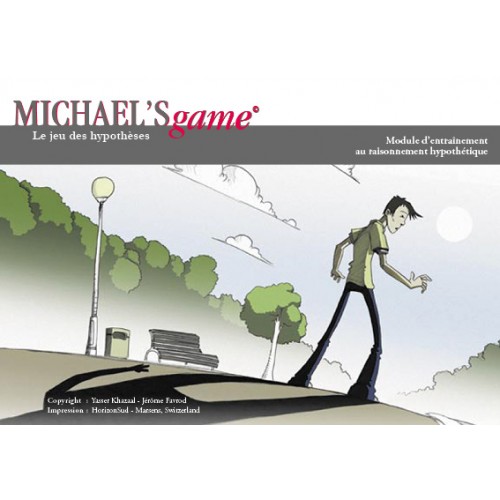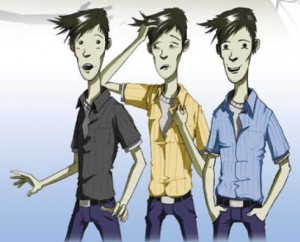Michael’s game est un jeu collaboratif basé sur le raisonnement hypothétique développé pour faciliter le traitement psychologiques des idées délirantes. Il a été testé dans une étude randomisée contrôlée qui montre que le jeu conduit à une réduction de la conviction et de la préoccupation avec les idées délirantes.
Michael’s game peut être obtenu auprès d’HorizonSud à info@horizonsud.ch
Le jeu « Michael’s Game » a été conçu pour spécifiquement entraîner le raisonnement par hypothèses. Il sélectionne spécifiquement cet aspect de l’approche cognitive des symptômes psychotiques [1, 2 , 3].
L’hypothèse au départ de ce jeu, conçu par Yasser Khazaal et Jerôme Favrod, a été que cet entraînement pourrait réduire les sauts aux conclusions (« jumping to conclusions ») [4, 5] ou, tout du moins, en réduire les effets, en facilitant l’ouverture à d’autres explications des phénomènes vécus [1, 2]. Cette approche semble d’autant plus importante à entraîner que la plupart des patients n’ont pas d’explications alternatives spontanées à leurs vécus [6] et qu’ils pourraient s’approprier ces approches [3] et en ressentir des bénéfices sur les symptômes psychotiques et/ou le vécu de ces symptômes ou la manière d’y faire face [1 , 7 , 8, 9, 10 , 11].
Malgré leur intérêt, les psychothérapies cognitives des psychoses, et l’entraînement au raisonnement par hypothèses connaissent une faible dissémination en milieu clinique [3 , 12 , 13].
En développant le jeu « Michael’s Game », les auteurs font l’hypothèse qu’il pourrait faciliter l’introduction de ces approches auprès des soignants et des patients. Les patients pourraient plus facilement les découvrir par le biais d’une approche décentrée et ludique, probablement plus acceptable. Également, les soignants pourraient plus facilement se lancer ou s’initier à ces approches en le faisant par le biais d’une approche structurée rapidement applicable.
Le jeu « Michael’s game »
Le jeu, rédigé en Français, a été traduit, à ce jour, en Anglais, Allemand, Espagnol, Italien et Portugais. IL comporte 80 cartes, qui chacune va entraîner ce même processus de raisonnement par hypothèses au travers de situations différentes. Le jeu est habituellement animé en groupe (le plus souvent de 4-8 joueurs). Les patients habituellement inclus sont sortis de la phase aiguë et pas trop sévèrement désorganisés. Leur état clinique doit être compatible avec le fait de participer à un groupe durant environ une heure à une heure-trente (avec une pause). Les animateurs sont des soignants formés à l’animation du jeu. Toutefois, pour animer le jeu, il n’est pas indispensable d’être formé en psychothérapie cognitive. Il est cependant préférable d’avoir une certaine expérience clinique du travail avec des patients présentant des symptômes psychotiques. La formation à l’animation de « Michael’s Game » dure deux heures. Elle permet une introduction aux concepts sur lesquels se base le jeu et un entraînement pratique à son animation.
1. Chadwick PD, Lowe CF: A cognitive approach to measuring and modifying delusions. Behaviour research and therapy 1994;32:355-367.
2. Beck AT, Rector NA: Cognitive therapy of schizophrenia: A new therapy for the new millennium. American journal of psychotherapy 2000;54:291-300.
3. Morrison AP, Renton JC, Williams S, Dunn H, Knight A, Kreutz M, Nothard S, Patel U, Dunn G: Delivering cognitive therapy to people with psychosis in a community mental health setting: An effectiveness study. Acta psychiatrica Scandinavica 2004;110:36-44.
4. So SH, Peters ER, Swendsen J, Garety PA, Kapur S: Changes in delusions in the early phase of antipsychotic treatment – an experience sampling study. Psychiatry research 2014;215:568-573.
5. Ross K, Freeman D, Dunn G, Garety P: A randomized experimental investigation of reasoning training for people with delusions. Schizophr Bull 2011;37:324-333.
6. Freeman D, Garety PA, Fowler D, Kuipers E, Bebbington PE, Dunn G: Why do people with delusions fail to choose more realistic explanations for their experiences? An empirical investigation. Journal of consulting and clinical psychology 2004;72:671-680.
7. Lecomte T, Leclerc C, Corbiere M, Wykes T, Wallace CJ, Spidel A: Group cognitive behavior therapy or social skills training for individuals with a recent onset of psychosis? Results of a randomized controlled trial. The Journal of nervous and mental disease 2008;196:866-875.
8. Carter CS, Barch DM, Buchanan RW, Bullmore E, Krystal JH, Cohen J, Geyer M, Green M, Nuechterlein KH, Robbins T, Silverstein S, Smith EE, Strauss M, Wykes T, Heinssen R: Identifying cognitive mechanisms targeted for treatment development in schizophrenia: An overview of the first meeting of the cognitive neuroscience treatment research to improve cognition in schizophrenia initiative. Biol Psychiatry 2008;64:4-10.
9. Zimmermann G, Favrod J, Trieu VH, Pomini V: The effect of cognitive behavioral treatment on the positive symptoms of schizophrenia spectrum disorders: A meta-analysis. Schizophr Res 2005;77:1-9.
10. Rector NA, Beck AT: Cognitive behavioral therapy for schizophrenia: An empirical review. The Journal of nervous and mental disease 2001;189:278-287.
11. Grant PM, Huh GA, Perivoliotis D, Stolar NM, Beck AT: Randomized trial to evaluate the efficacy of cognitive therapy for low-functioning patients with schizophrenia. Archives of general psychiatry 2012;69:121-127.
12. Kingdon DG, Kirschen H: Who does not get cognitive-behavioral therapy for schizophrenia when therapy is readily available? Psychiatric services (Washington, DC 2006;57:1792-1794.
13. Tarrier N: Cbt for psychosis: Effectiveness, diversity, dissemination, politics, the future and technology. World psychiatry : official journal of the World Psychiatric Association 2014;13:256-257.


